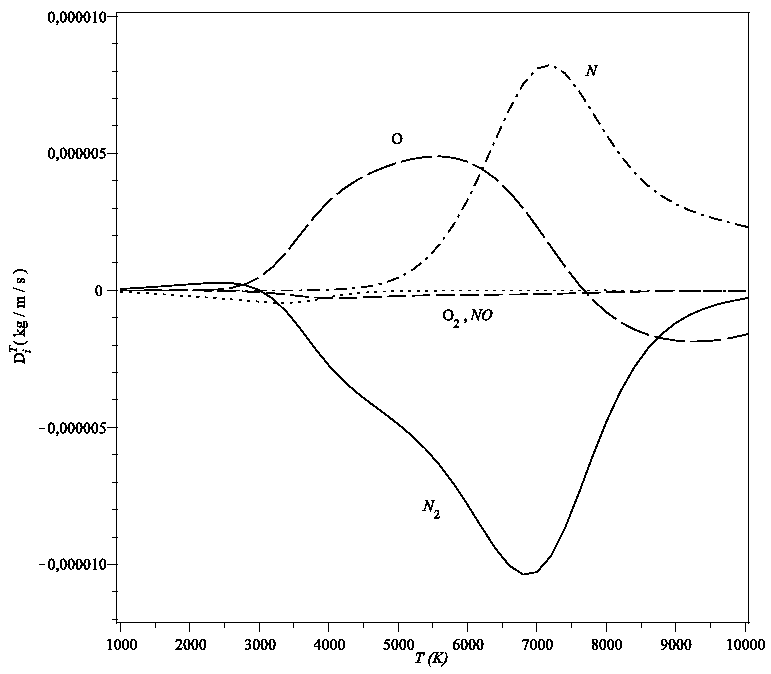Maxwell–Stefan diffusion on:
[Wikipedia]
[Google]
[Amazon]
 The Maxwell–Stefan diffusion (or Stefan–Maxwell diffusion) is a
The Maxwell–Stefan diffusion (or Stefan–Maxwell diffusion) is a
 The Maxwell–Stefan diffusion (or Stefan–Maxwell diffusion) is a
The Maxwell–Stefan diffusion (or Stefan–Maxwell diffusion) is a model
A model is an informative representation of an object, person, or system. The term originally denoted the plans of a building in late 16th-century English, and derived via French and Italian ultimately from Latin , .
Models can be divided in ...
for describing diffusion
Diffusion is the net movement of anything (for example, atoms, ions, molecules, energy) generally from a region of higher concentration to a region of lower concentration. Diffusion is driven by a gradient in Gibbs free energy or chemical p ...
in multicomponent systems. The equations that describe these transport processes have been developed independently and in parallel by James Clerk Maxwell
James Clerk Maxwell (13 June 1831 – 5 November 1879) was a Scottish physicist and mathematician who was responsible for the classical theory of electromagnetic radiation, which was the first theory to describe electricity, magnetism an ...
J. C. Maxwell: ''On the dynamical theory of gases'', The Scientific Papers of J. C. Maxwell, 1965, 2, 26–78. for dilute gases and Josef Stefan
Josef Stefan (; 24 March 1835 – 7 January 1893) was a Carinthian Slovene physicist, mathematician, and poet of the Austrian Empire.
Life and work
Stefan was born in the village of St. Peter (Slovene: ) on the outskirts of Klagenfurt) to A ...
J. Stefan: ''Über das Gleichgewicht und Bewegung, insbesondere die Diffusion von Gemischen'', Sitzungsberichte der Kaiserlichen Akademie der Wissenschaften Wien, 2te Abteilung a, 1871, 63, 63–124. for liquids. The Maxwell–Stefan equation is
* ∇: vector differential operator
* χ: Mole fraction
In chemistry, the mole fraction or molar fraction, also called mole proportion or molar proportion, is a quantity defined as the ratio between the amount of a constituent substance, ''ni'' (expressed in unit of moles, symbol mol), and the to ...
* μ: Chemical potential
In thermodynamics, the chemical potential of a Chemical specie, species is the energy that can be absorbed or released due to a change of the particle number of the given species, e.g. in a chemical reaction or phase transition. The chemical potent ...
* a: Activity
* i, j: Indexes for component i and j
* n: Number of components
* : Maxwell–Stefan-diffusion coefficient
* : Diffusion velocity of component i
* : Molar concentration
Molar concentration (also called molarity, amount concentration or substance concentration) is the number of moles of solute per liter of solution. Specifically, It is a measure of the concentration of a chemical species, in particular, of a so ...
of component i
* c: Total molar concentration
* : Flux
Flux describes any effect that appears to pass or travel (whether it actually moves or not) through a surface or substance. Flux is a concept in applied mathematics and vector calculus which has many applications in physics. For transport phe ...
of component i
The equation assumes steady state
In systems theory, a system or a process is in a steady state if the variables (called state variables) which define the behavior of the system or the process are unchanging in time. In continuous time, this means that for those properties ''p' ...
, i.e., the neglect of time derivatives in the velocity.
The basic assumption of the theory is that a deviation from equilibrium between the molecular friction and thermodynamic interactions leads to the diffusion flux.S. Rehfeldt, J. Stichlmair: ''Measurement and calculation of multicomponent diffusion coefficients in liquids'', Fluid Phase Equilibria, 2007, 256, 99–104 The molecular friction between two components is proportional to their difference in speed and their mole fractions. In the simplest case, the gradient
In vector calculus, the gradient of a scalar-valued differentiable function f of several variables is the vector field (or vector-valued function) \nabla f whose value at a point p gives the direction and the rate of fastest increase. The g ...
of chemical potential is the driving force of diffusion. For complex systems, such as electrolytic solutions, and other drivers, such as a pressure gradient, the equation must be expanded to include additional terms for interactions.
A major disadvantage of the Maxwell–Stefan theory is that the diffusion coefficient
Diffusivity, mass diffusivity or diffusion coefficient is usually written as the proportionality constant between the molar flux due to molecular diffusion and the negative value of the gradient in the concentration of the species. More accurate ...
s, with the exception of the diffusion of dilute gases, do not correspond to the Fick's diffusion coefficients and are therefore not tabulated. Only the diffusion coefficients for the binary and ternary case can be determined with reasonable effort. The Maxwell-Stefan diffusion coefficients can be, for example, estimated using the empirical Vignes correlation model or the physically-motivated entropy scaling. In a multicomponent system, a set of approximate formulas exist to predict the Maxwell–Stefan-diffusion coefficient.
The Maxwell–Stefan theory is more comprehensive than the "classical" Fick's diffusion theory, as the former does not exclude the possibility of negative diffusion coefficients. It is possible to derive Fick's theory from the Maxwell–Stefan theory.
See also
* Advanced Simulation Library *Pervaporation Pervaporation (or pervaporative separation) is a processing method for the separation of mixtures of liquids by partial vaporization through a non-porous or porous membrane.
Theory
The term ''pervaporation'' is a portmanteau of the two steps of ...
References
{{DEFAULTSORT:Maxwell-Stefan diffusion Diffusion James Clerk Maxwell